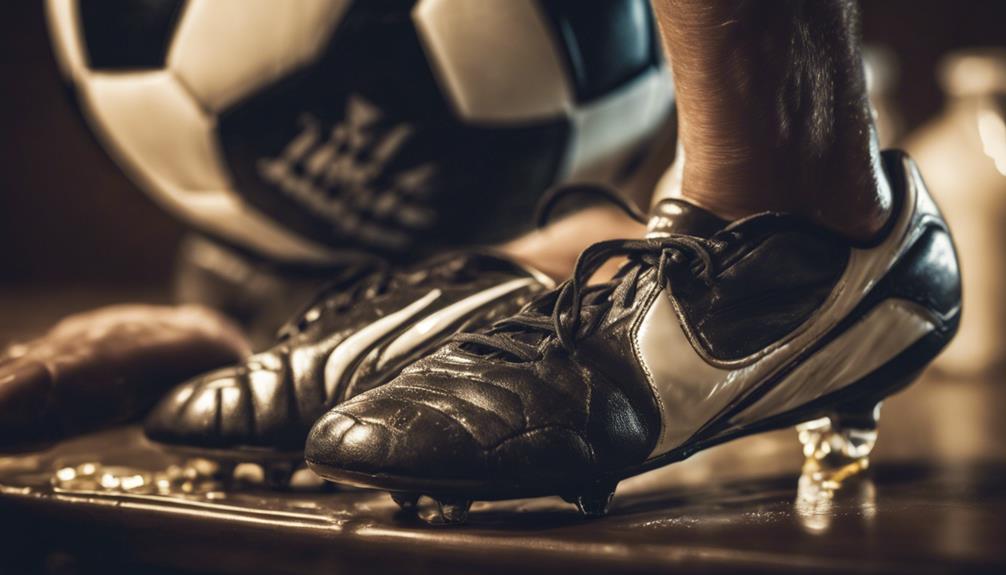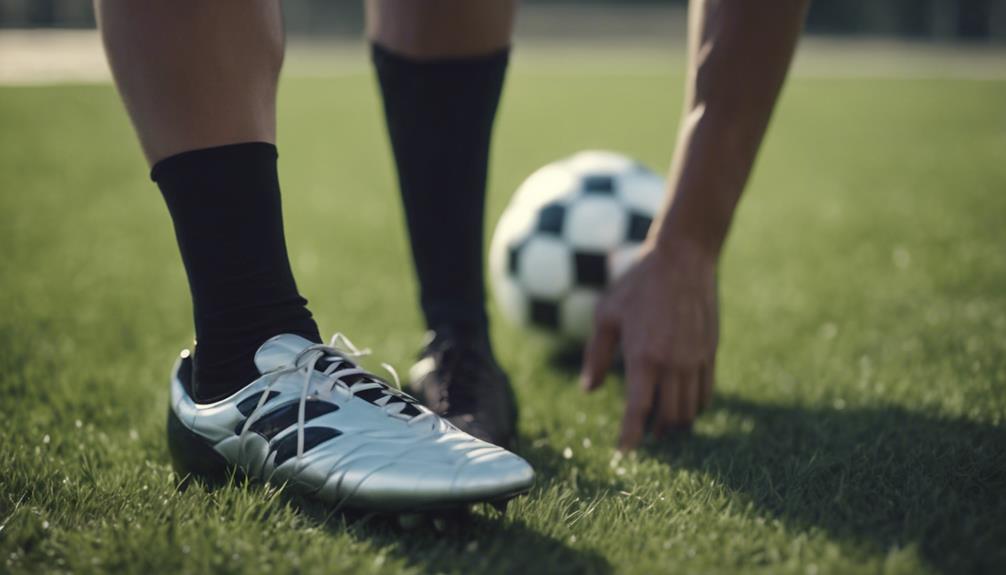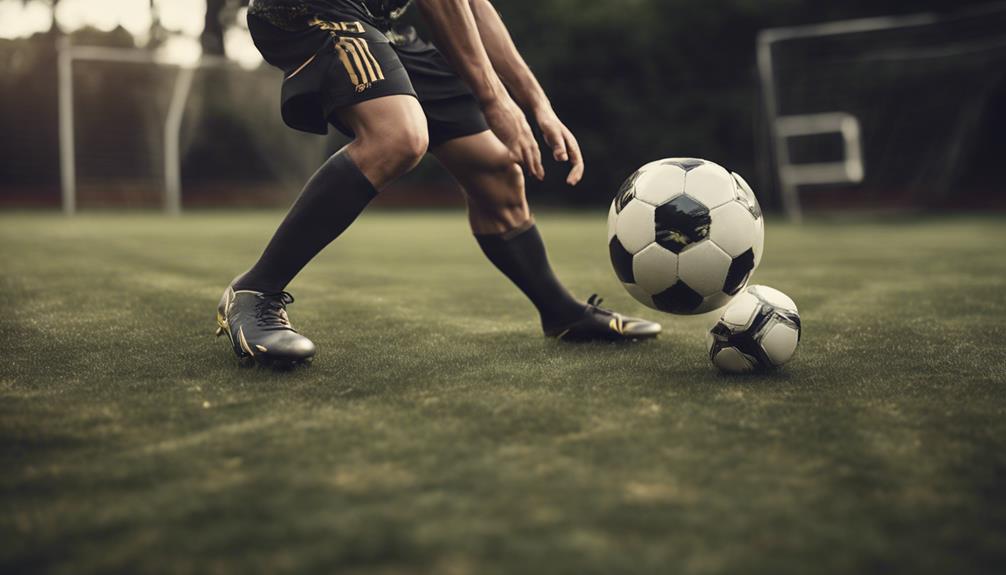
How to Break in Soccer Cleats for Maximum Comfort
July 16, 2024To break in your soccer cleats for maximum comfort, start by choosing the right size—a snug fit is key. Wet them in warm water to make them flexible and mold to your feet. Apply petroleum jelly for reduced discomfort and to soften the material. Stretch the uppers gently by flexing and stuffing cleats. Ease into training slowly to adjust and mold them to your feet. Remember, these simple steps can greatly enhance your performance and comfort on the field. So, keep these techniques in mind for the best soccer experience!
Choose the Right Size
When selecting soccer cleats, make sure you choose the right size to optimize performance and prevent discomfort on the field. Wearing cleats that are too small or too big can lead to blisters, discomfort, and potentially even injuries.
To feel comfortable and perform at your best, it's vital to find the right size. Soccer cleats are typically designed to fit half a size smaller than regular shoes to guarantee a snug fit. However, it's important to leave about a thumb's width of space at the toe to prevent any pain or issues.
By consulting size charts and considering foot measurements, you can determine the correct size for maximum comfort. Properly fitting cleats won't only enhance your performance but also reduce the risk of discomfort and potential foot problems while playing on the field.
Wet Them for Comfort
To guarantee maximum comfort while breaking in your soccer cleats, soaking them in warm water is a great way to make them more flexible and pliable.
Wetting your cleats helps them mold to your feet, providing a customized fit that enhances your overall playing experience.
Water for Flexibility
Soak your new soccer cleats in warm water for 20 minutes to soften the material and enhance flexibility. Wetting your cleats in warm water helps them mold to your feet, reducing discomfort and preventing blisters as you break them in.
For an even better fit, walk or jog in the wet cleats for about 30 minutes to allow them to conform to the shape of your feet. This method not only speeds up the breaking-in process but also enhances overall comfort during play.
After you've soaked and worn your cleats, let them air dry naturally. This will help maintain their shape and ensure they provide a customized fit tailored to your foot shape.
Socks for Fit
Wearing wet socks with your new cleats can greatly enhance their fit and comfort as you break them in. By soaking your socks in warm water before putting on your cleats, you can help mold the materials to the shape of your feet, creating a more customized fit.
This process softens the cleats, reducing discomfort and ensuring a better fit during the breaking-in period. Wet socks simulate the conditions of sweaty game days, accelerating the stretching and molding of the cleats for improved comfort.
The moisture from the wet socks aids in loosening tight areas in the cleats, making them more pliable and comfortable. Incorporating wet socks into your cleat-breaking routine can expedite the process of achieving a personalized fit, allowing you to enjoy maximum comfort on the field sooner.
Apply Petroleum Jelly

To guarantee flexibility and reduce discomfort from friction, applying petroleum jelly to your soccer cleats is a simple yet effective method.
By lubricating the interior of the cleats, you can prevent blisters and allow the material to mold comfortably to your feet.
This technique not only speeds up the breaking-in process but also maintains the suppleness of leather cleats for prolonged comfort on the field.
Lubricate for Flexibility
Enhance the flexibility of your new soccer cleats by applying petroleum jelly to the interior for a more comfortable breaking-in experience.
When you lubricate the inside of your cleats with petroleum jelly, you aren't only softening the materials but also reducing the risk of blisters.
The petroleum jelly acts as a lubricant that helps the leather become more pliable, enhancing the overall flexibility of the cleats.
By doing so, you decrease friction between the cleats and your skin, making the breaking-in process smoother and more comfortable.
To achieve maximum comfort and fit, consider using petroleum jelly in combination with other breaking-in techniques.
Regularly applying petroleum jelly will help maintain the softness of the cleats' interior over time, ensuring long-term comfort and flexibility.
Ease Friction Discomfort
Applying petroleum jelly inside your soccer cleats can effectively alleviate friction discomfort, ensuring a smoother break-in process. By using petroleum jelly, you can reduce friction between your feet and the cleats, minimizing the risk of blisters and discomfort during the break-in period. This simple yet efficient method also helps keep the leather of the cleats soft and pliable, aiding in the molding process for maximum comfort while playing.
To make the most of this technique, consider jogging or walking in your wet cleats with petroleum jelly applied for around 30 minutes. This allows the petroleum jelly to penetrate the material, enhancing its effectiveness in reducing friction and discomfort.
Stretch the Uppers
Start by gently flexing and bending the soccer cleats to stretch the uppers for a comfortable fit. When breaking in your new pair of cleats, especially those made of synthetic materials, it's important to focus on stretching the uppers to enhance the initial fit and feel.
To begin, wear your cleats around the house for short periods. As you move, deliberately flex your feet to help the synthetic materials loosen up. You can also use your hands to gently stretch the upper areas of the cleats, focusing on spots that feel tight or restrictive.
Moreover, consider stuffing your cleats with a slightly damp towel to help expand the material without causing damage. This method can aid in softening the uppers and molding them to your feet more quickly.
Ease Into Training

Gradually ease into training with your new soccer cleats by starting with light sessions to allow for a comfortable and personalized fit. Here's how to effectively break in your new soccer cleats:
- Start Slowly: Begin by wearing your new cleats for short periods during light training sessions. This will help you get accustomed to the feel and fit of the shoes without causing discomfort.
- Focus on Comfort: Prioritize getting used to the cleats before engaging in intense gameplay. This approach can prevent blisters and other discomforts during the break-in period.
- Progress Gradually: Increase the duration and intensity of your training sessions while wearing the cleats. This gradual adjustment will aid in molding the cleats to your feet over time.
- Rotate Cleats: Alternate between your new soccer cleats and older, more comfortable ones. This practice helps prevent excessive wear on the new cleats and gives your feet a break as you continue breaking them in.
Proper Drying Techniques
To uphold the quality and longevity of your soccer cleats, make sure proper drying techniques are employed after cleaning them. After cleaning your cleats, stuff them with newspaper to maintain their shape and absorb moisture effectively.
Avoid placing them in direct sunlight or near heat sources as this can damage the materials. Proper drying techniques not only help prevent mold, odors, and premature deterioration of the cleats but also guarantee they maintain their quality for longer.
Allow your cleats to air dry thoroughly before storing them in a cool, dry place. Consider using a shoe tree or adjustable shoe stretcher to help maintain the shape of the cleats during the drying process.
Quick Break-In Tips

For a quick and effective break-in process, consider wearing your new soccer cleats around the house for short periods. This allows your feet to get accustomed to the fit of the new pair gradually.
Here are some quick break-in tips for maximum comfort:
- Use a shoe stretcher or thick socks: Help expand the cleats slowly to achieve a better fit without causing discomfort.
- Apply leather conditioner: Soften the material of the cleats to prevent blisters and make the break-in process smoother.
- Walk or jog in short intervals: This helps mold the cleats to your feet while minimizing any potential discomfort during the break-in period.
- Give it time: Allowing your cleats to break in naturally is essential. Rushing the process can lead to discomfort and even injuries, so patience is key in achieving maximum comfort with your new soccer cleats.
Conclusion
Now that you know how to break in your soccer cleats for maximum comfort, you'll be kicking goals in no time!
Remember, Rome wasn't built in a day, so be patient and give your cleats the time they need to mold to your feet.
With these tips and a little perseverance, you'll be running circles around the competition in no time.
Happy playing!


